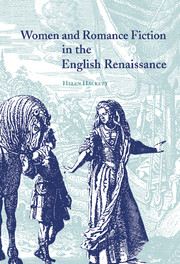Book contents
- Frontmatter
- Contents
- Acknowledgements
- List of abbreviations and a note on the text
- Introduction
- 1 The readership of Renaissance romance
- 2 Renaissance romance and modern romance
- 3 Novellas of the 1560s and 1570s
- 4 Spanish and Portuguese romances
- 5 Fictions addressed to women by Lyly, Rich and Greene
- 6 The ‘Arcadia’: readership and authorship
- 7 The ‘Arcadia’: heroines
- 8 ‘The Faerie Queene’
- 9 Shakespeare's romance sources
- 10 Lady Mary Wroth's ‘Urania’
- Epilogue: The later seventeenth century
- Notes
- Bibliography
- Index
8 - ‘The Faerie Queene’
Published online by Cambridge University Press: 01 September 2009
- Frontmatter
- Contents
- Acknowledgements
- List of abbreviations and a note on the text
- Introduction
- 1 The readership of Renaissance romance
- 2 Renaissance romance and modern romance
- 3 Novellas of the 1560s and 1570s
- 4 Spanish and Portuguese romances
- 5 Fictions addressed to women by Lyly, Rich and Greene
- 6 The ‘Arcadia’: readership and authorship
- 7 The ‘Arcadia’: heroines
- 8 ‘The Faerie Queene’
- 9 Shakespeare's romance sources
- 10 Lady Mary Wroth's ‘Urania’
- Epilogue: The later seventeenth century
- Notes
- Bibliography
- Index
Summary
IMAGINED READERS
At first The Faerie Queene, like the Arcadia, looks as if its ideal imagined reader is an individual woman – in this case, Queen Elizabeth I. Each of the six completed books opens with a proem which directly addresses her. Yet the terms of these addresses are very different from those used by Sidney to his sister. Where Sidney's dedication is warmly intimate, Spenser abases himself before the remote splendour of Gloriana: she is a ‘Goddesse heavenly bright’, ‘Great lady of the greatest Isle’, whom he implores to ‘raise my thoughts too humble and too vile’. Whereas Sidney's dedication invites all readers to imitate the projected reading manner of his sister, responding to the text with tolerance and affectionate complicity, clearly no reader, either female or male, can aspire to the divine judgement of Gloriana.
The obvious difference here is between a sister and a ruler: Spenser's representations of Elizabeth, including the representations of her as his highest and most discerning reader, are shaped by the conventions of panegyric. Bluntly, he praises her, including praise of her reading skills, in hope of reward and preferment. As many critics have noted, however, his praise becomes increasingly ambivalent as the poem proceeds, moderated perhaps by disappointment that he had not received the rewards he hoped for, perhaps by larger disillusionment that she had failed fully to live up to his ideal of the Protestant monarch.
- Type
- Chapter
- Information
- Women and Romance Fiction in the English Renaissance , pp. 130 - 139Publisher: Cambridge University PressPrint publication year: 2000



